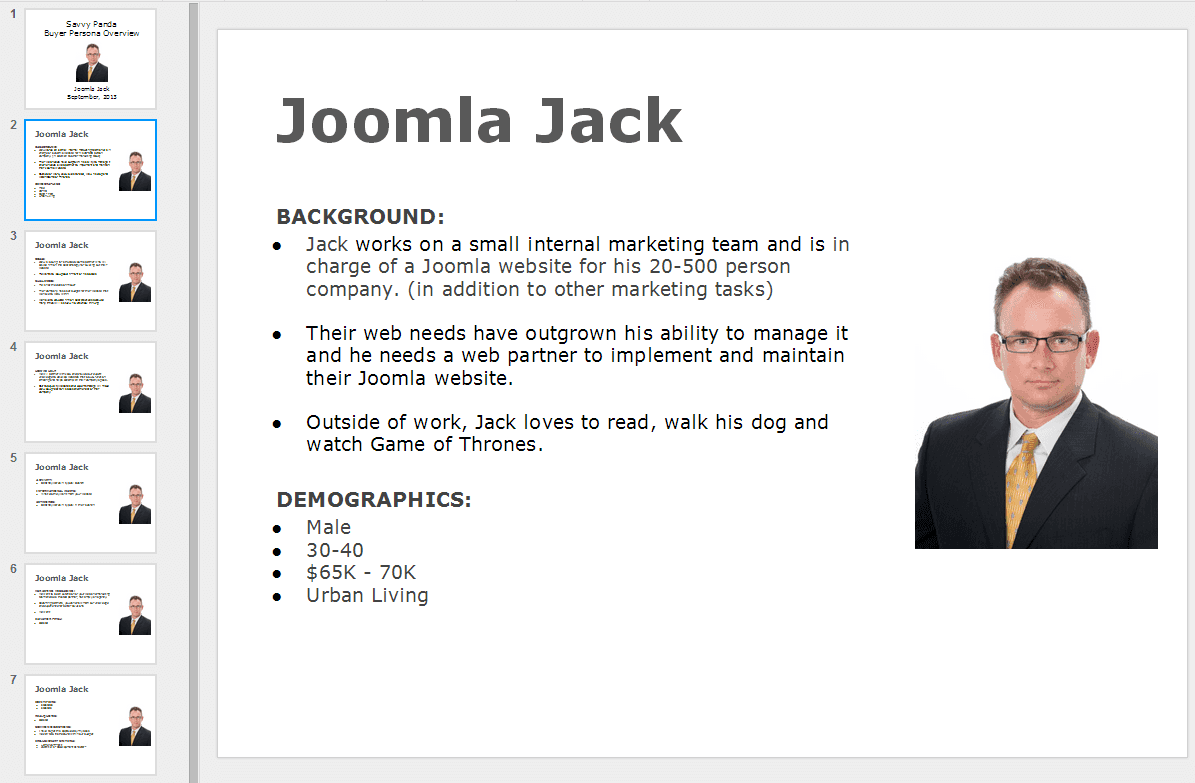Buyer personas: you hear about them everywhere in the Inbound world. From strategy development to lead nurturing to advocacy, buyer personas are constantly credited as the heart of Inbound marketing tactics. But what is a buyer persona, really? And how do you create one?
In the simplest terms, a buyer persona is a fictional representation of your ideal buyer.
Personas are profiles usually presented in a slide deck that details their background information, goals, and means of interacting with your brand. In truly comprehensive Inbound strategies, buyer personas are the first order of business. Before writing copy, mapping nurturing campaigns, or planning messaging, you outline the personas who all of those elements will speak to.
Here's a snapshot of a sample persona:

Don't be thrown off by the picture. A buyer persona is NOT a snapshot of an actual customer - remember, it's a fictional representation of a collection of ideal customer traits. We use the image (a stock photo) to help us visualize this person, but they're not someone we actually market to.
What goes into creating buyer personas?
Here's a quick rundown:
- Background - who is this person? If you're B2B, this will be more professionally focused. In B2C, you'll usually want to explore more of their life outside work. But regardless of your segment, try to draw out traits that paint a more personal picture of the individual.
- Demographic and psychographic information - Everything you'd include in a standard target audience profile: age, HHI, hobbies, mannerisms, etc.
- Goals and challenges - What does this person want to accomplish, and how does your product or service help them do so? This could be looking good to the boss, providing healthy meals to their family, becoming fluent in Spanish...anything they want to do with an offering like yours.
- Objections - Your persona has a problem, you have a solution... what might keep them from choosing you? Common objections include price sensitivity, existing brand preference, or a poor previous experience.
- Common identifiers - What is a "dead giveaway" for this individual? This is often a job title in B2B, or more personal psychographic trait in B2C.
- Exclusionary criteria - For every ideal customer, there's a less desirable one. Exclusionary traits are another "dead giveaway", but they signify a lead you don't want to pursue. Reasons to exclude a customer group could be low CLV, high service demands, and so forth.


All of this information seems very valuable, right? Unfortunately, many companies remain at a loss as to where to find it.
Research
Since buyer personas are representations of real customers, their profiles are not simply made up. Here are a few ways to accurately gather the necessary information:
- If you use a CRM, run a report and segment based on what you'd consider an "ideal customer". Look for shared traits among these individuals.
- Talk to your sales team. If you are your sales team, think about the different kinds of people you sell to. What are the common uses of your product? Who are the common groups of people making use of each application?
- Interview your current or past customers. If you have a close relationship with a handful of customers, simply ask for five minutes of their time. If you'd like to broaden your sample group or need to incentivize participation, consider sending an email survey with a gift for participating. Either way works, but interviews always offer more in-depth insight.
With your personas in place, it's time to start building on that solid, customer focused foundation. A few popular ways to use personas include:
- Segmenting lead nurturing campaigns
- Determining which social networks to focus on
- Selecting the best messaging for copy
- Structuring your website for information seeking
- Product/feature development
Now, hop to it and let me know how your persona development goes!

